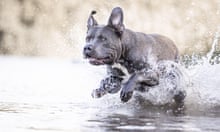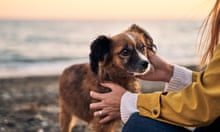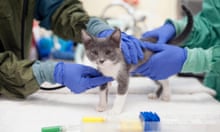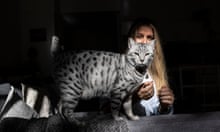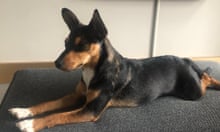There are Gucci hats made in Italy from pink bouclé wool, Celine travel bags with calfskin trim and a (waste bag) purse studded with gold spikes. But these are not just any designer fashion items … they’re created for clients with four legs and a tail.
In the past year, numerous fashion houses have launched ranges for pets, including Gucci, Celine, Tommy Hilfiger, Hugo Boss and Christian Louboutin. Dolly Parton also launched her own line of dog clothes in 2022, with the name Doggy Parton.
And even the catwalk (or dogwalk?) has found a space for your furry friend. This month, the fashion calendar began with the menswear event Pitti Uomo in Italy and, alongside the latest styles for men, was a new event, PittiPets, dedicated to clothing, accessories and homeware for cats and dogs.
“We’d been thinking about expanding the Pitti Uomo lifestyle boundaries for some time,” says Antonio Cristaudo, a director of Pitti Immagine. “A growing market has been created as a result of strong consumer demand.”
The global pet clothing market is expected to be worth $7bn by 2032 with an annual growth rate of 5%. Sales of clothing for animals have grown by 21% since 2019 and the average amount spent by owners has increased by 9%. Dogs have the biggest wardrobes, with 60% of pet clothes bought by their owners. In the UK alone, annual spending on pets exceeded £7.5bn in 2020, according to the Pet Food Manufacturing Association, and there are more than 34million British pets.
Some of the newer offerings have been inspired by designers’ own pets. Gucci’s collection of jumpers, coats and travel carriers was made with creative director Alessandro Michele’s Boston terriers Bosco and Osco in mind. Celine’s range of leads, poo bag pouches and bowls, designed by Hedi Slimane, was created for his labradoodle, Elvis.
This isn’t just a trend for luxury fashion. High-street brands such as H&M have also created dog clothes. Chris Corbin, commercial director at the UK’s biggest pet care chain Pets at Home, said sales of dog jumpers and hoodies were up more than 60% year-on-year. “This is driven by an increasing number of pet owners, and pets becoming an integral part of the family in a growing humanisation trend.”
Changes in the demographics of pet ownership have helped drive this trend. Nearly two-thirds of those who recently acquired a pet in the UK are aged between 16 and 34. These millennial and Gen Z owners tend to treat their pets as an extension of their human family, and are more likely to buy food, accessories and clothing similar to products they would buy for themselves.
Ileana Ciamarone, co-founder of sustainable Italian pet brand Omniagioia, has created dog bowls, jumpers and coats using recycled materials and 3D printing. Ecologically sound products that reduce a pet’s carbon pawprint are gaining popularity, she says. “Large quantities of plastic materials are consumed in the petcare market so reducing that by using 100% recyclable material was a goal for us. Our line also has a minimal aesthetic for people who are animal and design lovers.”
The interest in clothes for animals has coincided with the rise of pet influencers on Instagram and TikTok. Italian greyhound Tika the Iggy and Boobie Billie, an Italian greyhound chihuahua mix, lead the pack on social media with brand deals and fashion collaborations.
Tea Kainu is CEO of Paikka, a Finnish pet clothing brand showing at PittiPets. She has made coats for her dogs since she was 14 and thinks their clothing should be viewed in the same way as human fashion. “You can design products from a dog’s perspective but still make them fashionable. The clothes should also be in department and lifestyle stores rather than pet shops,” she says.
“Why wouldn’t you want to buy your furry friend’s winter jacket from the same place and at the same time as when you buy one for yourself? And, in best case scenarios, those jackets would be matching.”

